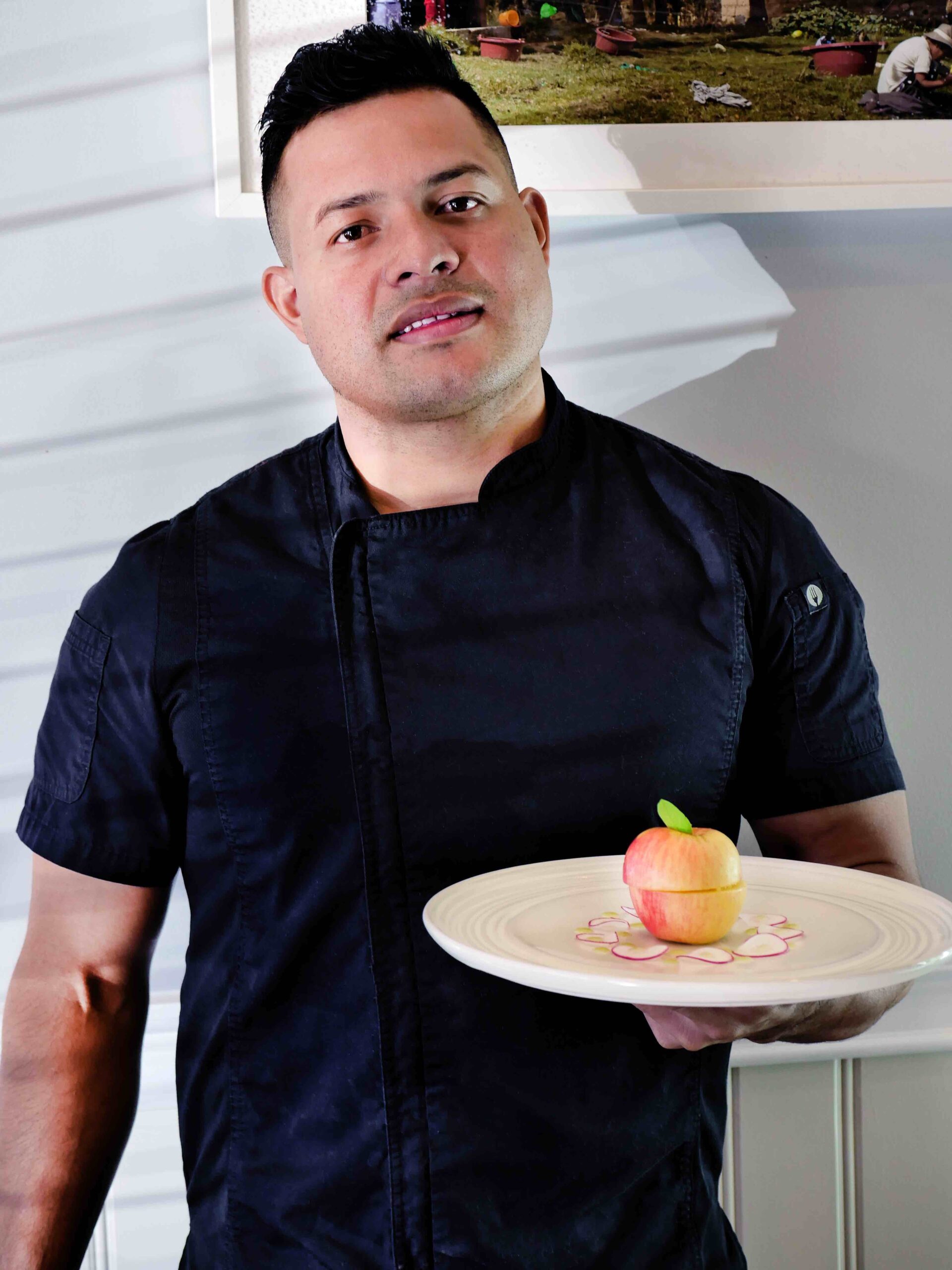Chef Elmer Oliveros enjoys fine dining, and he’ll save for an entire year to indulge in the tasting menu at Per Se. “I see God while I eat, and it’s amazing,” he says. But it’s always difficult to get his friends to go with him – it’s intimidating, and he can relate.
“I remember going to a restaurant and they gave me 20 forks,” Oliveros says. “I was with someone else, and we just looked at the forks. When the server brought us the first course, he watched us to see what fork we would use. But we weren’t taught this in school, so I just grabbed a fork and began eating.”
“For me, there are no rules,” he continues. “So, I killed the protocol. You don’t have to sit a certain way, use a certain fork or drink a certain wine at my restaurant. I made it about the food and about introducing this type of food to people who don’t know about it.”
And that’s why, when we want to treat ourselves, you’ll find us enjoying the tasting menu at Brothers Fish & Chips in Ossining. Oliveros’ approach to fine dining and his customers is not only refreshing, it’s incomparable. At only $130 per person (plus tax and gratuity), you’ll receive at least eight extraordinary courses – each one customized for your table, based on Oliveros’ conversations with you and what you inspire him to create. And every time a new course is placed in front of you, it’s Oliveros who is there to explain exactly what you are about to eat, where the food came from, what inspired him and the steps he took to create that dish.
What makes this restaurant even more impressive is Oliveros’ background – he’s had no formal training; everything you see and taste is a result of his tremendous natural talent. He has the innate ability to perfectly combine flavors and textures – every dish is a work of art for the eyes and the palate. Plus, he’s a gifted storyteller, describing his food in a way that demonstrates the love and the time that goes into each dish (52 ingredients in his mole, which takes three months to make, for example).
And he does it all with a humility and passion that you’d be hard-pressed to find at any Michelin-starred restaurant in Manhattan.

Humble Beginnings
Oliveros grew up working on his family’s farm in Guatemala, and when he moved to New York at the age of 16, it was American food that was the biggest shock.
“We grew up thinking that we had nothing – we had limited money and we wanted so many things we couldn’t have, and we forgot to appreciate the food,” he says. “We had fresh milk from the cows, fresh eggs from the chickens and beans and vegetables from the backyard. Our breakfast was made from scratch every morning, and when I moved to the U.S., I was introduced to something completely different. The food looked amazing, but it tasted like nothing to me. I remember having such culture shock and not getting the same joy from food.”
Oliveros attended night school and spent his days working in the seafood department at a local grocery store, which served as his introduction to a variety of crustaceans and very large fish. But his boss, “an amazing fishmonger,” wouldn’t allow or teach him how to cut or scale the fish, so Oliveros carefully observed his techniques.
Eventually, one of his colleagues allowed Oliveros to cut the tails off the salmon when the manager wasn’t around. His skills improved, and when he learned of a new fish and chips place opening in Ossining, he saw it as his opportunity to finally cut fish. Oliveros began working at Lonnie’s Fish n’ Chips – a tiny takeout restaurant in a strip mall – when he was 18 years old. His only job was to cut the fish.
“After I cut the fish, I would go cook at several other restaurants,” he says. “I learned by watching other chefs, but I would also taste food. And while I’m not a critic, I would think, ‘What if it had this ingredient, or if I did that this way.’ It wasn’t because I thought it would be better, but because that’s the way I would like it to be. So, I had my own interpretation of dishes, which was a big advantage and a big problem; I wasn’t able to replicate dishes for chefs because I wanted to do my own version of things.”
Within that same year, he began cooking at Lonnie’s.
“Eventually, I was running the place, and I was only 18 years old,” he says. “The owners didn’t want to do it because it was too much work. It was 2009, which wasn’t a great time to be in the restaurant industry. Food prices kept going up, but their prices were very low – they were selling everything for only $7 and losing about $3 on every order. The owner tried to sell the business, but no one would buy it.”
About a year later, Oliveros asked his younger brother, Kevin, who was in culinary school, if he would buy the restaurant with him, and he said yes.
“We were cooking at a good level, but we were not taken seriously because we were very young,” he remembers. “So, we went to the owner and told him we wanted to buy the restaurant, and he laughed. He said, ‘With what money?’ We told him that no one else will buy the restaurant, so he was better off selling it to us and recovering some of the money. He thought about it and realized that we were the only choice. We changed the name to Brothers Fish and Chips.”

Turning Dreams into Reality
Oliveros and his brother bought the restaurant in late 2010, expanded the menu, made it profitable and paid off the previous owner. Eventually, they began serving food that wasn’t meant for takeout. In late 2013, Oliveros started dreaming of opening a sit-down restaurant, but he couldn’t afford a new space with a new kitchen. As luck would have it, the strip mall with Oliveros’ restaurant was sold, and the barber who leased the space next door didn’t get along with the new owner, so he left.
Oliveros approached his brother, who was now working at a restaurant in Armonk several days a week, and suggested they take the space.
“My brother didn’t think opening another restaurant in Ossining was a good idea,” he says. “But he went in anyways.”
They spent a year remodeling the space while continuing to run their own kitchens, finally opening a casual restaurant that only served a tasting menu.
“But it was still intimidating if you didn’t know what a tasting menu was, so it didn’t work,” he said.
They eventually introduced a seasonal menu and offered a tasting menu to anyone who asked. It took two to three years for locals to really understand the concept. Oliveros now runs both the takeout and dine-in restaurants (Kevin is the head chef and owner of Risotto in Thornwood); 70 percent of his overall business is takeout. Next door, he continues to offer a seasonal menu and a tasting menu to anyone who reserves one in advance, up to 17 per week. About 90 percent of the customers who dine in do so for the tasting menu, which he presents in an unpretentious and very personal manner.
“There are a lot of people who love tasting menus for the whole experience – they want the VIP parking and to have a cocktail at the bar before moving to their table,” he says. “They want 10 waiters on them the whole time. They want the attention; they’re paying for the attention. But you won’t get that here. When you come here, it’s very casual. You’re coming for the food, which I think is the whole point of a tasting menu.”
Every dish he creates is an expression of his passion for food and his deep appreciation for the customers who choose him as their chef.
“For me, it’s more than cooking; it’s creating an experience with my food,” he says. “It’s celebrating your highs and your failures. Because in the end, whenever we feel happy, we laugh and we eat, and when we are sad, we cry and we eat. I’m grateful to be a part of that. When people chose me to cook for them, I try to give them an experience that, hopefully, they will never forget. And if they do, then I’ve failed.”
This article was published in the January/February 2023 print edition of Katonah Connect.
Gia Miller is an award-winning journalist and the editor-in-chief/co-publisher of Connect to Northern Westchester. She has a magazine journalism degree (yes, that's a real thing) from the University of Georgia and has written for countless national publications, ranging from SELF to The Washington Post. Gia desperately wishes schools still taught grammar. Also, she wants everyone to know they can delete the word "that" from about 90% of their sentences, and there's no such thing as "first annual." When she's not running her media empire, Gia enjoys spending quality time with friends and family, laughing at her crazy dog and listening to a good podcast. She thanks multiple alarms, fermented grapes and her amazing husband for helping her get through each day. Her love languages are food and humor.











